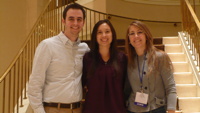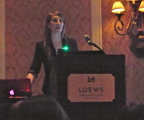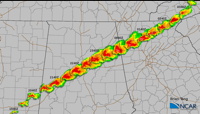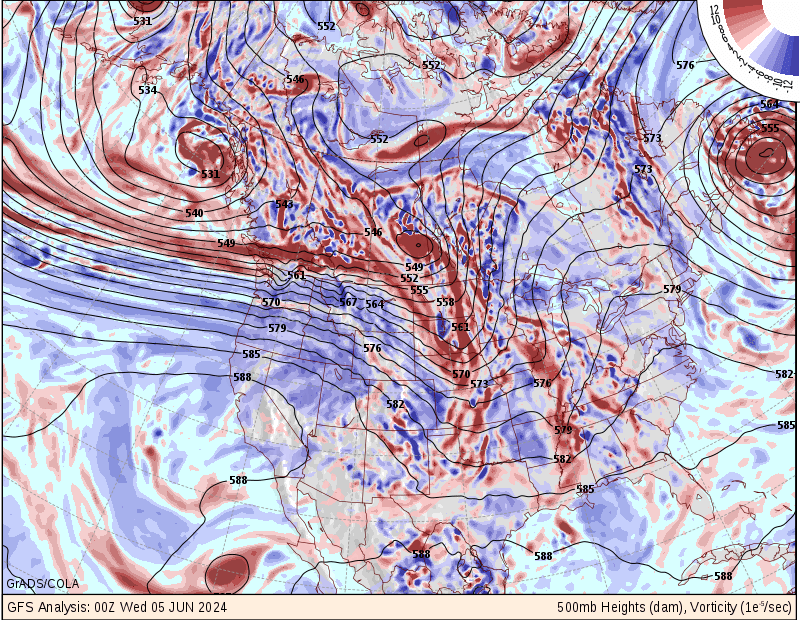Convective
Modeling Group
Atmospheric
Sciences Department & NCSA
University of Illinois at Urbana-Champaign
26th Conference on Severe Local Storms
 The
AMS 26th Conference
on Severe Local Storms was held in Nashville, TN from November
5-8, 2012. Attending from the Univ. Illinois Convective Modeling Group
were (left-to-right in photo) M.S. graduate students Kevin Van Leer
and Samantha Chiu, research assistant Ann Syrowski (M.S. May 2012),
and (not pictured) PI's Robert Wilhelmson and Brian Jewett. Kevin,
Samantha, and Ann had oral presentations at the meeting.
The
AMS 26th Conference
on Severe Local Storms was held in Nashville, TN from November
5-8, 2012. Attending from the Univ. Illinois Convective Modeling Group
were (left-to-right in photo) M.S. graduate students Kevin Van Leer
and Samantha Chiu, research assistant Ann Syrowski (M.S. May 2012),
and (not pictured) PI's Robert Wilhelmson and Brian Jewett. Kevin,
Samantha, and Ann had oral presentations at the meeting.
Storm Interaction
 Ann Syrowski presented
the findings of her M.S. thesis, "An assessment of internal and
external forcings in supercell interactions and their impact on
storm morphology." The structure and evolution similarities and
differences among a single-storm control case and 51 two-storm
simulations were discussed, and intensification mechanisms were
identified. The dynamic connections between (and timings of) a key
sequence of events were identified for the control and selected strong
and weak 2-storm cases:
(1) wet microbursts reached the surface behind the forward flank
downdraft (FFD), (2) shallow rotation centers formed along and moved
down the FFD, and (3) subsequent near-surface rotation intensification
episodes (mesocyclonesis) occurred. Ann is preparing a manuscript for
submission to Monthly Weather Review.
Ann Syrowski presented
the findings of her M.S. thesis, "An assessment of internal and
external forcings in supercell interactions and their impact on
storm morphology." The structure and evolution similarities and
differences among a single-storm control case and 51 two-storm
simulations were discussed, and intensification mechanisms were
identified. The dynamic connections between (and timings of) a key
sequence of events were identified for the control and selected strong
and weak 2-storm cases:
(1) wet microbursts reached the surface behind the forward flank
downdraft (FFD), (2) shallow rotation centers formed along and moved
down the FFD, and (3) subsequent near-surface rotation intensification
episodes (mesocyclonesis) occurred. Ann is preparing a manuscript for
submission to Monthly Weather Review.
Long-Track Tornadoes: The April 27, 2011 Outbreak
 Samantha Chiu presented
the findings of her ongoing master's work on long-track
tornadoes and simulations of the 27 April 2011 tornado outbreak. Over
300 tornadoes struck the southeast U.S. in the outbreak*, including
the devastating Tuscaloosa-Birmingham EF-4 tornado with a damage path
80 miles long and up to 1.5 miles wide (radar
sequence at left, ©NCAR). Chiu's real-data
simulations of the event, with high resolution (0.3-km grid spacing)
simulations of the outbreak, feature two long-lived supercell storms
including one very near the track and timing of the Birmingham storm.
Samantha is using these simulations and complimentary idealized runs
with the Weather Research and Forecasting (WRF) model to assess the
environment along the path of the storms and understand the stability
and shear conditions under which such a long-track tornado could
occur.
Samantha Chiu presented
the findings of her ongoing master's work on long-track
tornadoes and simulations of the 27 April 2011 tornado outbreak. Over
300 tornadoes struck the southeast U.S. in the outbreak*, including
the devastating Tuscaloosa-Birmingham EF-4 tornado with a damage path
80 miles long and up to 1.5 miles wide (radar
sequence at left, ©NCAR). Chiu's real-data
simulations of the event, with high resolution (0.3-km grid spacing)
simulations of the outbreak, feature two long-lived supercell storms
including one very near the track and timing of the Birmingham storm.
Samantha is using these simulations and complimentary idealized runs
with the Weather Research and Forecasting (WRF) model to assess the
environment along the path of the storms and understand the stability
and shear conditions under which such a long-track tornado could
occur.
*See also AMS presentation
by K. Knupp
Storm Mergers and Rapid Intensification in the 2011 Joplin Tornadic Storm
![]() Kevin
Van Leer's talk was on "Rapid intensification mechanisms
including the role of storm mergers in the 22 May 2011 Joplin, MO
tornadic storm." The presentation first addressed the unusual
and somewhat surprising severity and rapid development of the storm
and the environmental conditions in place at the time of the
devastating tornado in Joplin. Mechanisms which could contribute to
this intensification were discussed, including storm mergers that
occurred before the tornado. High-resolution (0.3 km) modeling of this
case also produced mergers, and animations of simulated mergers, the
structure and evolution of precipitation, and low level rotation in
the simulation were used to investigate the relationship between
boundaries, cell movement, descending reflectivity cores and
near-surface vorticity generation. Kevin is continuing this work
toward his M.S. degree. His presentation won a student award at the
SLS meeting, and his preliminary findings are the subject of a Bulletin
of the American Meteorology Society meeting note (accepted;
in February BAMS).
Kevin
Van Leer's talk was on "Rapid intensification mechanisms
including the role of storm mergers in the 22 May 2011 Joplin, MO
tornadic storm." The presentation first addressed the unusual
and somewhat surprising severity and rapid development of the storm
and the environmental conditions in place at the time of the
devastating tornado in Joplin. Mechanisms which could contribute to
this intensification were discussed, including storm mergers that
occurred before the tornado. High-resolution (0.3 km) modeling of this
case also produced mergers, and animations of simulated mergers, the
structure and evolution of precipitation, and low level rotation in
the simulation were used to investigate the relationship between
boundaries, cell movement, descending reflectivity cores and
near-surface vorticity generation. Kevin is continuing this work
toward his M.S. degree. His presentation won a student award at the
SLS meeting, and his preliminary findings are the subject of a Bulletin
of the American Meteorology Society meeting note (accepted;
in February BAMS).

























